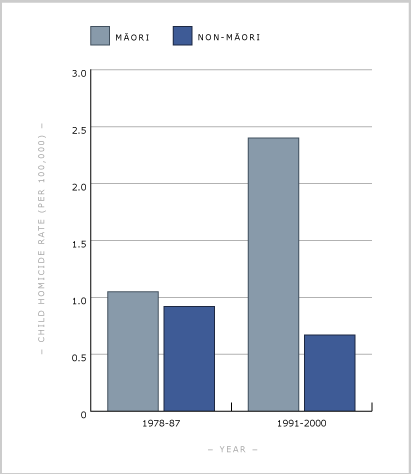Between 1978 and 1987, Māori and non‑Māori children were dying at almost the same rate - around 1 child per 100,000 was murdered. Then suddenly, something snapped. By the 1990s, the Māori child-homicide rate more than doubled, while the non‑Māori rate actually dropped. So what the hell happened?
Between 1978 and 1987, child homicide rates in New Zealand were relatively equal between Māori and non‑Māori, roughly one child killed per 100,000. But by the 1990s, something horrifying happened. The rate of Māori children being killed skyrocketed, more than doubling, while the rate for non‑Māori declined. The numbers don’t lie. Between 1991 and 2000, Māori children were being killed at more than three times the rate of non‑Māori. It was a wave of violence that ripped through homes and whānau, and the victims were the smallest and most vulnerable.

Click graph to view - SOURCE: c/en/graph/29237/child-homicide-rates-for-maori-and-non-maori
Forget the excuses. This wasn’t just about politics or poverty. It was about violence. Raw, brutal, unrelenting violence happening behind closed doors. Babies thrown against walls. Toddlers smothered. Kids beaten until their hearts stopped. We need to stop dressing this up in academic language and say it plainly - Māori children were being murdered by their own. That truth is uncomfortable, but it’s necessary.
Violence had taken hold. Not just from individuals, but across whānau where dysfunction had been normalised. Where abuse was ignored. Where silence was the rule. Generational cycles of harm played out in real time, and the result was a generation of tamariki never given the chance to grow up.
This is not about blaming culture. Māori values are apparently built on protection, aroha, and collective responsibility. When those values are lost, when violence replaces manaakitanga, when rage replaces whakapapa, the outcomes are bloody deadly.
We can’t pretend this was a one-off. We can’t say it was the times. This was a crisis that ran deep and wide. The data speaks volumes, but it’s the names and faces we’ll never know that matter most.
The rise in Māori-led solutions after 2000 helped bring the numbers down. It shouldn’t have taken that many dead children to force change. It doesn’t absolve what happened in the decade prior. We need to confront the truth. A generation of Māori children were killed, not by strangers, but often by the very people meant to protect them.
Violence destroyed lives. Not government policy. Not economics. Violence. Until that’s named, faced, and rejected at every level, we risk repeating the same horrific cycle.
No more silence. No more euphemisms. Name the violence, stop the violence, and protect our tamariki. Kati te kohuru tamariki - stop murdering children.
Matua Kahurangi is just a bloke sharing thoughts on New Zealand and the world beyond. No fluff, just honest takes. He blogs on https://matuakahurangi.com/ where this article was sourced.


10 comments:
Could the use of drugs be a major factor? Yes alcohol used unwisely is bad but the damage caused by drugs hugely underestimated.
Most of the killers will be men. After the 1980s the standing of the labourer was much reduced. Meanwhile mere women, using their children as hostages, were equipped to lever generous benefits, a house etc from the State and effectively became the prime takeaway winner. The diminished status of men frustrated the superior warrior tradition and their Jake the Muss inherent character.
.
I've got to say this...deep breath... When one looks at the environment these kids are being raised in, each murder, tragic though it is, removes another future gang member or gangster's moll from humanity...
The increase in infant abuse and murders appears to coincide with the rise of meth in NZ. By late 1990’s use of P had evidently “exploded”. Gangs and their malign societal influences no doubt rose in a similar time frame on the proceeds. Also of note is the ongoing perverse incentive for young, particularly lower socio females to produce children in order to receive the DPB and a housing allowance. There’s a few reasons for starters.
Roger Douglas & Richard Prebble happened.
Drugs - of all types.
Scratch the surface and you will always find the "state" stirring the "problem/reaction/solution" pot. (I'm from the government and here to help philosophy)
Bang on anon 0928. I returned from a 12 year overseas trip in 2003 and couldn't believe treacherous meth was nzs drug of choice.
Drugs, Rogernomics being followed by the Mother of all Budgets and benefit cuts; loss of blue-collar jobs through the period.
roromi
1. (verb) (-a) to squeeze, grasp.
Show example
2. (verb) (-a,-tia) to strangle, suffocate, carry out infanticide.
Post a Comment
Thank you for joining the discussion. Breaking Views welcomes respectful contributions that enrich the debate. Please ensure your comments are not defamatory, derogatory or disruptive. We appreciate your cooperation.